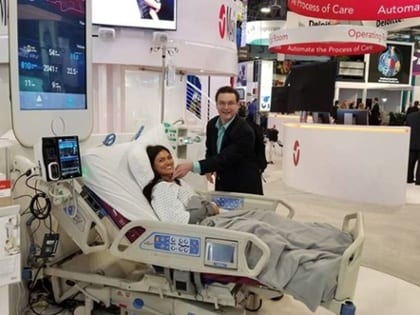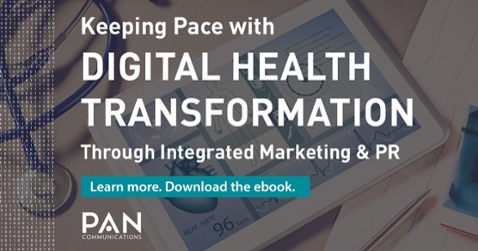The dust has finally settled after more than 45,000 attendees and nearly 1,500 vendors have returned from HiMSS 2018 in Las Vegas. Couldn’t make it out? Not to worry! PAN Communications was onsite and has you covered with a few of our takeaways. We had a great time visiting booths, attending educational sessions, rubbing elbows with the influencers, and stopping in to the Interoperability Showcase, Innovation Live exhibit and Population Health Solutions Lab. In general, it was great just spending time getting a finger on the pulse of all that is happening in the world of digital health today. Even if you were there, it was a long four days jam-packed with a lot of information, so it’s always nice to have a consolidated summary.
 Data, Data Everywhere
Data, Data Everywhere
Not surprising, data played a major role at the conference. We’re all aware that as the technology revolution continues to drive healthcare, the proliferation of data is massive—data is coming in from every conceivable source including EHRs/EMRs, insurance records, wearable sensors, lab tests and procedures, medical imaging, claims, payment processing, and even social media use. All of this information is giving healthcare providers a tremendous opportunity to draw a more comprehensive picture of the patient, in turn improving care, engagement, and the ability to facilitate more seamless transactions. Analytics stemming from this data is also playing a key role in creating, accumulating and storing insights.
At HiMSS, the thrust of the conversation aligned with being able to pull all of this data together holistically and not just certain data from various one-off sources. Lots of companies in Las Vegas were talking about and demonstrating what can be done to truly provide a single view into all data forms, regardless of source (both inside and outside of a medical setting; for example, in the home). This provides a unique vantage point into all aspects of a patient’s medical history, care and status. Not siloed. Not only some data sources. Everything.
From a vision standpoint, it was all the rage. From a real-world standpoint, there is still a little way to go, but some companies are knocking on the door.
Make sure you check out, The Building Blocks of Effective Marketing for Healthcare Companies.
Interoperability
If I had to pick one theme that most permeated the show it would be interoperability (and data exchange). Building off the last point around data, interoperability is the standard-based technology behind exchanging real-time health data to support continuity of care and improve outcomes. It was so big, in fact, that it occupied its own 34,000 square foot showcase! Organizations could use the space to collaborate and highlight the unique value their products and systems could provide, building a connected story focused on a patient, caregiver, and/or clinician.
In order for the healthcare market to evolve to a point at which the delivery of care can be as seamless as possible for caregivers, providers and patients, the discussion centered largely on the importance for all parties to be able to track and monitor patients as they move through the care journey. This journey could take them in network, out of network, across their PCP and specialist community, and involve any of their past medical issues, prescriptions and procedures. This not only stands to improve the overall experience, but it will also raise the bar on the quality of care and, ideally, reduce costs.
Population Health
The “Triple Aim” is still in full swing, even if you don’t hear that term used verbatim—and, we didn’t at the show. Its core tenants—improving care, reducing costs, improving population health—were all on full display, however. It’s pretty obvious that any and all innovations out there today are in place with the purpose of, in some way, reducing costs and improving care. Why else would they exist? In particular, what was interesting was the emphasis on population health.
In addition to HiMSS dedicating an entire solutions lab to showcasing the innovation taking place across the payer-provider-employer landscape, there was also a lot of buzz about how to effectively manage population health, from conversations on the floor to educational sessions. What’s perhaps most interesting are the solutions that companies are creating to develop better data analysis, improve engagement, gain transparency and measure impact across the board.
Check out this blog post by Dan Martin, Health IT Areas to Watch in 2018.
Patient Empowerment / Engagement
As the healthcare system looks for ways to improve care and reduce costs, engaging and empowering the patient is key. With more information and access to resources, patients can better understand their treatment options, make more informed decisions about their care, and have more of a voice when communicating with their doctors. It also allows employers, payers and even providers to engage with patients at various points in time throughout the year—not just around open enrollment. More frequent and personalized communication can catch poor habits (such as smoking/tobacco use) and chronic conditions (obesity, diabetes) before they progress too far and are beyond the point of effective treatment. Targeting people with relevant content and wellness information, and in some cases using gamification, based on where they are in their lives and on their healthcare journey, is critical. For example, a 25-year-old male might not be interested in a notification for a PAP smear much like his female counterparts of the same age. In fact, it could cause him to ignore future communications that might be relevant.
You might also be interested in reading, Inspiring and Motivating the Empowered Patient.
Based on what we saw and heard at HiMSS, look for companies to continue to develop tools, offerings, and technology platforms aimed at getting more decision-making information into the hands of consumers and patients. As part of that, we can expect to see more targeted, engaging ways to touch those very patients on a more regular basis with content that relates to them more personally.
At PAN Communications our healthcare team is working with clients across the spectrum of B2B Health IT and, more specifically, within the digital health space. These are companies exposed to the daily opportunities and challenges associated with building a brand in today’s ever-changing healthcare market.
Have an integrated marketing or PR need? Check us out at www.pancommunications.com or, better yet, look at what we’re doing in healthcare by visiting https://www.pancommunications.com/expertise/healthcare-pr/.




